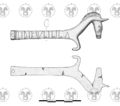NO-11 bronze: Difference between revisions
From Thesaurus Inscriptionum Raeticarum
Jump to navigationJump to search
Sindy Kluge (talk | contribs) No edit summary |
No edit summary |
||
| Line 13: | Line 13: | ||
|inventory_number=1.086 | |inventory_number=1.086 | ||
|accessibility=on exhibition | |accessibility=on exhibition | ||
|source=Schumacher 2004: 152 | |source=Schumacher 2004: 152 | ||
|checklevel=3 | |checklevel=3 | ||
|problem=object type -> im Ferdinandeum als Applike bezeichnet vgl. Kommentar; Datierung: laut Museum Ende 5. Jh. v. Chr. | |problem=object type -> im Ferdinandeum als Applike bezeichnet vgl. Kommentar; Datierung: laut Museum Ende 5. Jh. v. Chr. | ||
}} | }} | ||
==Commentary== | ==Commentary== | ||
'''Find circumstances''': In 1883 a bronze situla filled with different kinds of bronze objects like fibulae and pendants was found on a ridge west of Dercolo. Moreover the situla contained a set of fortune rods (?Losstäbchen) (in latin ''sortes'') and appliqués in the form of horses. | See '''{{bib|Wieser 1883}} ?''', {{bib|Oberziner 1883}}: 190 ff., '''{{bib|Zemmer & al. 1985}}: 165 (Kat.-Nr. 35)'''. Pictures in {{bib|Oberziner 1883}}: Tav. II,9 (drawing) and {{bib|Mancini 2010}}: 165 (photo and drawing); both also mention and give pictures of a a similar find from the same hoard.<br>'''Find circumstances''': In 1883 a bronze situla filled with different kinds of bronze objects like fibulae and pendants was found on a ridge west of Dercolo. Moreover the situla contained a set of fortune rods (?Losstäbchen) (in latin ''sortes'') and appliqués in the form of horses. | ||
After Mancini the situla was found in march 1882 (see {{bib|Mancini 2010}}: 164). | After Mancini the situla was found in march 1882 (see {{bib|Mancini 2010}}: 164).<br>'''Interpretation''': The collection of the wealth deposit can be interpreted as a votive hoard. | ||
'''Interpretation''': The collection of the wealth deposit can be interpreted as a votive hoard. | |||
{{bibliography}} | {{bibliography}} | ||
Revision as of 22:11, 1 November 2013
| Object | |
|---|---|
| Proper name: | Pferdchen von Dercolo |
| Classification: | statuette |
| Material: | bronze |
| Size: | 11.9 cm |
| Condition: | complete |
| Date: | 4th to 3rd century BC |
|
| |
| Site: | Dercolo (fraction of: Campodenno, Trento, Trentino-Alto Adige, Italy) |
| Archaeological context: | hoard |
| Coordinates (approx.): | 46° 14' 56.40" N, 11° 2' 49.20" E [from site] |
| Find date: | 1883 |
| Current location: | Tiroler Landesmuseum Ferdinandeum (on exhibition) |
| Inventory Nr.: | 1.086 |
|
| |
| Inscription: | NO-11 (pirikaniśnu) |
|
| |
| Sources: | Schumacher 2004: 152 |
Images
|
Object NO-11 bronze with inscription NO-11.
|
Commentary
See Wieser 1883 ?, Oberziner 1883: 190 ff., Zemmer & al. 1985: 165 (Kat.-Nr. 35). Pictures in Oberziner 1883: Tav. II,9 (drawing) and Mancini 2010: 165 (photo and drawing); both also mention and give pictures of a a similar find from the same hoard.
Find circumstances: In 1883 a bronze situla filled with different kinds of bronze objects like fibulae and pendants was found on a ridge west of Dercolo. Moreover the situla contained a set of fortune rods (?Losstäbchen) (in latin sortes) and appliqués in the form of horses.
After Mancini the situla was found in march 1882 (see Mancini 2010: 164).
Interpretation: The collection of the wealth deposit can be interpreted as a votive hoard.
Bibliography
| LIR | Alberto Mancini, Le Iscrizioni Retiche [= Quaderni del dipartimento di linguistica, Università degli studi di Firenze Studi 8–9], Padova: Unipress 2009–10. (2 volumes) |
|---|
